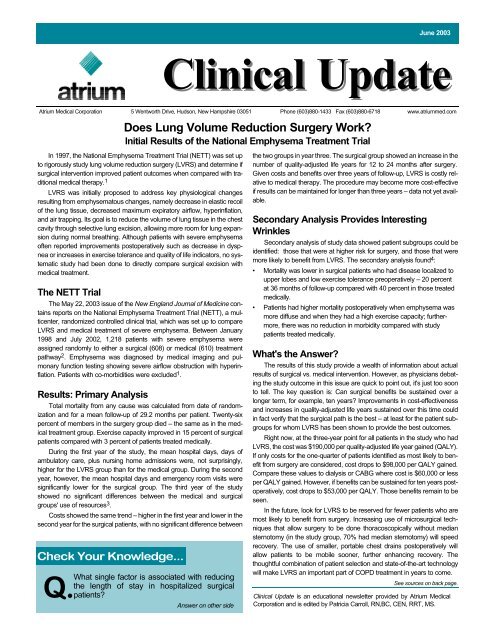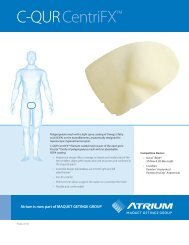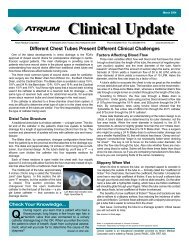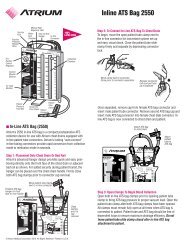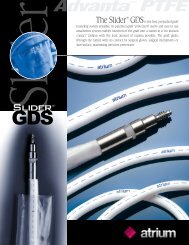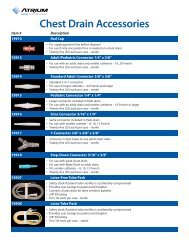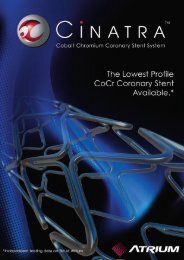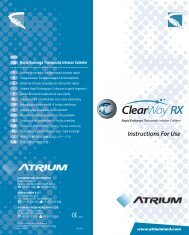Clinical Update - Atrium Medical Corporation
Clinical Update - Atrium Medical Corporation
Clinical Update - Atrium Medical Corporation
- No tags were found...
You also want an ePaper? Increase the reach of your titles
YUMPU automatically turns print PDFs into web optimized ePapers that Google loves.
June 2003<strong>Clinical</strong> <strong>Update</strong><strong>Atrium</strong> <strong>Medical</strong> <strong>Corporation</strong> 5 Wentworth Drive, Hudson, New Hampshire 03051 Phone (603)880-1433 Fax (603)880-6718 www.atriummed.comIn 1997, the National Emphysema Treatment Trial (NETT) was set upto rigorously study lung volume reduction surgery (LVRS) and determine ifsurgical intervention improved patient outcomes when compared with traditionalmedical therapy. 1LVRS was initially proposed to address key physiological changesresulting from emphysematous changes, namely decrease in elastic recoilof the lung tissue, decreased maximum expiratory airflow, hyperinflation,and air trapping. Its goal is to reduce the volume of lung tissue in the chestcavity through selective lung excision, allowing more room for lung expansionduring normal breathing. Although patients with severe emphysemaoften reported improvements postoperatively such as decrease in dyspneaor increases in exercise tolerance and quality of life indicators, no systematicstudy had been done to directly compare surgical excision withmedical treatment.The NETT TrialThe May 22, 2003 issue of the New England Journal of Medicine containsreports on the National Emphysema Treatment Trial (NETT), a multicenter,randomized controlled clinical trial, which was set up to compareLVRS and medical treatment of severe emphysema. Between January1998 and July 2002, 1,218 patients with severe emphysema wereassigned randomly to either a surgical (608) or medical (610) treatmentpathway 2 . Emphysema was diagnosed by medical imaging and pulmonaryfunction testing showing severe airflow obstruction with hyperinflation.Patients with co-morbidities were excluded 1 .Results: Primary AnalysisTotal mortality from any cause was calculated from date of randomizationand for a mean follow-up of 29.2 months per patient. Twenty-sixpercent of members in the surgery group died – the same as in the medicaltreatment group. Exercise capacity improved in 15 percent of surgicalpatients compared with 3 percent of patients treated medically.During the first year of the study, the mean hospital days, days ofambulatory care, plus nursing home admissions were, not surprisingly,higher for the LVRS group than for the medical group. During the secondyear, however, the mean hospital days and emergency room visits weresignificantly lower for the surgical group. The third year of the studyshowed no significant differences between the medical and surgicalgroups' use of resources 3 .Costs showed the same trend – higher in the first year and lower in thesecond year for the surgical patients, with no significant difference betweenCheck Your Knowledge...Q.Does Lung Volume Reduction Surgery Work?Initial Results of the National Emphysema Treatment TrialWhat single factor is associated with reducingthe length of stay in hospitalized surgicalpatients?Answer on other sidethe two groups in year three. The surgical group showed an increase in thenumber of quality-adjusted life years for 12 to 24 months after surgery.Given costs and benefits over three years of follow-up, LVRS is costly relativeto medical therapy. The procedure may become more cost-effectiveif results can be maintained for longer than three years – data not yet available.Secondary Analysis Provides InterestingWrinklesSecondary analysis of study data showed patient subgroups could beidentified: those that were at higher risk for surgery, and those that weremore likely to benefit from LVRS. The secondary analysis found 4 :• Mortality was lower in surgical patients who had disease localized toupper lobes and low exercise tolerance preoperatively – 20 percentat 36 months of follow-up compared with 40 percent in those treatedmedically.• Patients had higher mortality postoperatively when emphysema wasmore diffuse and when they had a high exercise capacity; furthermore,there was no reduction in morbidity compared with studypatients treated medically.What's the Answer?The results of this study provide a wealth of information about actualresults of surgical vs. medical intervention. However, as physicians debatingthe study outcome in this issue are quick to point out, it's just too soonto tell. The key question is: Can surgical benefits be sustained over alonger term, for example, ten years? Improvements in cost-effectivenessand increases in quality-adjusted life years sustained over this time couldin fact verify that the surgical path is the best – at least for the patient subgroupsfor whom LVRS has been shown to provide the best outcomes.Right now, at the three-year point for all patients in the study who hadLVRS, the cost was $190,000 per quality-adjusted life year gained (QALY).If only costs for the one-quarter of patients identified as most likely to benefitfrom surgery are considered, cost drops to $98,000 per QALY gained.Compare these values to dialysis or CABG where cost is $60,000 or lessper QALY gained. However, if benefits can be sustained for ten years postoperatively,cost drops to $53,000 per QALY. Those benefits remain to beseen.In the future, look for LVRS to be reserved for fewer patients who aremost likely to benefit from surgery. Increasing use of microsurgical techniquesthat allow surgery to be done thoracoscopically without mediansternotomy (in the study group, 70% had median sternotomy) will speedrecovery. The use of smaller, portable chest drains postoperatively willallow patients to be mobile sooner, further enhancing recovery. Thethoughtful combination of patient selection and state-of-the-art technologywill make LVRS an important part of COPD treatment in years to come.See sources on back page.<strong>Clinical</strong> <strong>Update</strong> is an educational newsletter provided by <strong>Atrium</strong> <strong>Medical</strong><strong>Corporation</strong> and is edited by Patricia Carroll, RN,BC, CEN, RRT, MS.
In The LiteratureAging and Shift Work: Keys to the NursingShortageAn article in a recent issue of Nursing Economic$ examines the ongoingnursing shortage from a unique perspective: how to manage roundthe-clockneeds with an aging workforce.According to author Elizabeth Ellen Cooper, hospitals need to work toretain experienced nurses while recruiting and training younger nurses. Inaddition, employers need to find ways to offset the negative impacts ofnight shift work, including providing sleeping areas, more flexible scheduling,job sharing, and more ergonomic working environments. She assertsthat retaining even two nurses at a facility (replacement cost, $60,000 pernurse) would more than offset the cost incurred for these improvementsbut concludes that more research is needed to explore these crucial issuesfor nurses and nursing practice.Source: Cooper EE: Pieces of the shortage puzzle: aging and shift work. NursingEconomic$ 2003;21(2):75-79.Family Presence: Benefit, Inconvenience, orHarm?Should family members be present when their loved one is beinggiven CPR or undergoing another invasive procedure? An article in thecurrent issue of the American Journal of Critical Care reports the results ofa survey of critical care and emergency room nurses. The 30-item surveywas mailed randomly to 1,500 members of the American Association ofCritical-Care Nurses and 1,500 members of the Emergency NursesAssociation. The survey consisted of demographic questions as well asqueries about the respondent's preferences, practices, and hospital policiesrelated to family presence during CPR and invasive procedures.Results showed that only 5% of respondents worked in units that hadwritten family presence policies. Despite the lack of any formal policy, familypresence was supported during CPR by 45% of nurses and during invasiveprocedures by 51%. Forty percent of those surveyed had escorted afamily member to the patient's bedside. About 25% reported barring familymembers during these procedures.Since only 5% of units had written policies, it is clear that nurses workingin all hospital areas need to develop clear policies and proceduresabout family presence. Perhaps a consultation with our colleagues in thedelivery room, who faced this issue many years ago, would be helpful. Thestudy authors call for more research into this important area and encourageunits to explore and develop written policies and guidelines that meetthe needs of nurses, patients, and families.Source: MacLean SL, Guzzetta CE, White C, Fontaine D, Eichhorn DJ, Meyers TA, andDesy P. Family presence during cardiopulmonary resuscitation and invasive procedures:practices of critical care and emergency nurses. American Journal of Critical Care2003;12(3):246-257.Strategies for Decreasing MedicationAdministration ErrorsMedication administration errors (MAE) are a major concern for healthcare institutions, nurses, and patients. An article in the current issue ofMedSurg Nursing discusses the potential for applying airline safety practicesto medication administration. The author suggests that the healthcare industry follow the lead of the airline industry in five areas:1. Establish a safety culture2. No conversation during medication administration (just as there's noconversation during the most critical parts of flight-takeoff and landing)3. Use teamwork (check and cross-check)<strong>Clinical</strong> <strong>Update</strong> for the Professional Nurse June 20034. Establish clear lines of authority to limit interruptions (medication administratorsshould wear a visible symbol of their role, plus a large printname tag that indicates job title -- RN, LPN, or Medication Tech -- justas flight crews wear distinctive uniforms)5. Use a checklist (standard medication protocol for medication administration,just as airlines use a standard takeoff and landing checklist)The author suggests further research to replicate these ideas in multiplesettings and nursing models, as well as identifying the most effectivesymbols to designate medication administration and ways to decrease distractionduring medication administration.This is not the first time nurse researchers have looked to airline pilots– you may recall that The Dreyfus Model of Skill Acquisition, which formedthe basis for Patricia Benner's Novice to Expert matrix was initially developedto study airplane pilots' performance. Creative application of modelsdesigned for other professions provide a rich opportunity to enhance nursingpractice.Source: Pape, TM. Applying airline safety practices to medication administration. MED-SURG Nursing 2003; 12(2):77-93.On theWorld Wide Web...You can explore a number of web sites to learn more about theNational Emphysema Treatment Trial, as well as general informationabout emphysema. Here are some of the best sites.http://www.emphysemastudy.orgThis site provides information about emphysema, the NETT, aglossary of medical terms, information about study enrollmentand sites (however, enrollment is now closed). There's also a newslink to recent press releases about the NETT and an easy-to-use"contact us" link. You can find more news releases onhttp://www.nhlbi.nih.gov/new/press/03-05-20.htm.http://clinicaltrials.gov/show/NCT00000606This site, a service of the National Institutes of Health, linkspatients with information about current medical research. Thissection of the site focuses on the NETT. A useful feature is a listof links at the bottom of the page, which provide direct access tojournal articles about the NETT.http://www.nhlbi.nih.gov/health/prof/lung/nett/lvrsweb.htmThis site also describes the NETT study in detail and gives specificinformation about emphysema and LVRS.Sources:1. National Emphysema Treatment Trial Research Group. Rationale and design ofthe National Emphysema Treatment Trial: a prospective randomized trial of lungvolume reduction surgery. Chest 1999;116:1750-1761.2. National Emphysema Treatment Trial Research Group. A randomized trial comparinglung-volume-reduction surgery with medical therapy for severe emphysema.NEJM 2003;348:2059-2073.3. National Emphysema Treatment Trial Research Group. Cost effectiveness of lungvolume-reductionsurgery for patients with severe emphysema. NEJM;2003;348:2092-2102.4. Ware JH.The national emphysema treatment trial - how strong is the evidence?NEJM; 2003;348:2055-2056.Don’t miss out!<strong>Clinical</strong> <strong>Update</strong> is going electronic. If you haven’tsigned up for the electronic version,please send an email to:clinicalupdate@atriummed.comCheck Your Knowledge...A.The earlier patients get out of bed and walk, thesooner they go home.


